Annual Open Letter to the People of Purdue from Mitch Daniels
January 2018
One of these years, maybe I’ll be able to begin this letter by reporting that it was a placid, relaxed year across the higher education landscape. Not yet.
Again, total enrollments nationwide dropped, by another 1%. This makes a 1 million, or more than a 5%, loss in five years.[i] If it weren’t for the growth in nonresidential online education, the plunge would look even steeper.[ii]
Some of the trouble hit sadly close to home. Among the dozen or more colleges that announced their closure were our neighbors at St. Joseph’s College just up the road at Rensselaer, and the Valparaiso University School of Law. It’s not yet clear that this is the “tsunami” that Stanford President John Hennessy predicted for traditional residential education a few years back.[iii] But it might be, in which case our duty at your university is to identify higher ground and strive to gain safety by reaching it. All the new projects and goals we set for ourselves these days have this basic purpose.
Innovation Within and Without
As a sector, American higher education is home to a number of ironies. Perhaps the most discussed in recent years is the sad extent to which the places where free inquiry and the clash of ideas should be most revered have often become bastions of conformity and groupthink. But another paradox is that so many of these hothouses of scientific and technical innovation, which give birth to so many miracles, are themselves so antiquated in the way they organize and manage their own affairs.
At Purdue, we work constantly to improve what has now been internationally recognized as one of the premier ecosystems for innovation anywhere.[iv] Late last year, we held our annual Inventors Night, when we honored the faculty who received patents the previous twelve months. Purdue is now No. 12 in the world in U.S. utility patents. The only institutions ahead of us that, like us, do not operate a medical school, are Caltech and MIT.
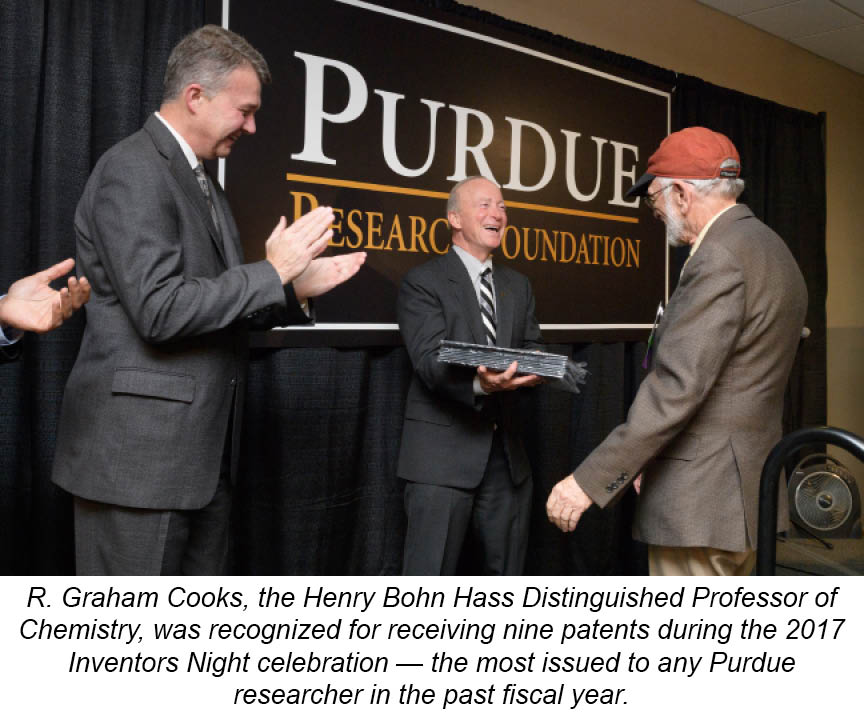
Shortly thereafter, we threw a party to celebrate the 165 companies that have started on our campus the last four years. Here, too, is a record achieved by only a few universities anywhere in the world.
At Purdue, we seek to behave as we encourage our students to do, as experimenters and innovators. Our affordability policy (described below), which we see as simply a matter of duty and common sense, is regularly described as some kind of breakthrough.
Better examples include our transformed Purdue Polytechnic Institute (formerly the College of Technology), with its hands-on, project-based learning model, that is headed toward granting degrees on the basis of competence, not on the traditional calendar and credits system.
Similarly, the institute’s Purdue Polytechnic High School opened in August, with an oversubscribed enrollment of 158. Last year’s letter outlined the enormous challenges this project faces in meeting the assignment to take freshmen in the Indianapolis Public Schools and, four years later, qualify them for Purdue admission. One semester cannot tell us the chances of success, but the school is off to a good start and has bolstered our hopes not only for success on that site but ultimately for its replication in other Hoosier cities, creating a pipeline of low-income and first-generation students to our campuses.
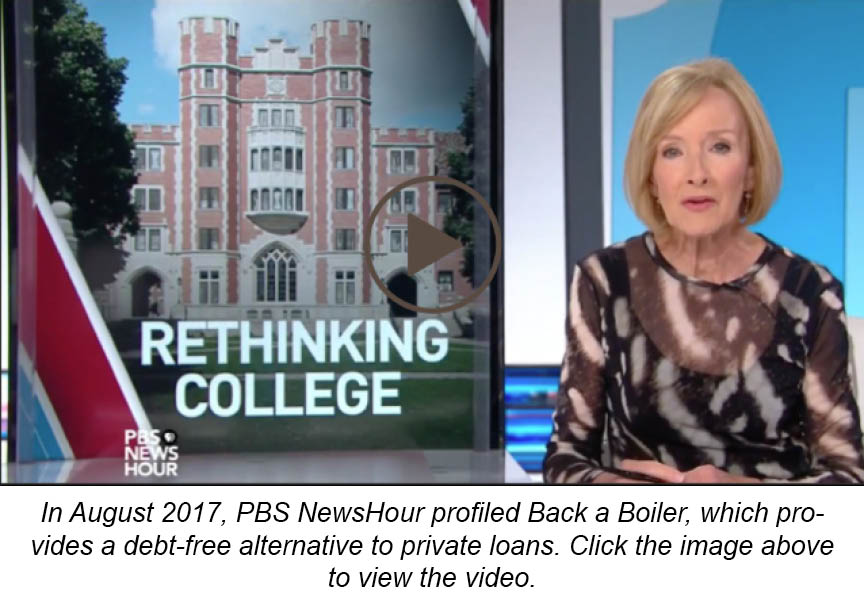
Another of our unique endeavors advanced this year when the second cohort of Income Share Agreements were signed by 280 sophomores, juniors and seniors. This brings the total of ISAs in effect to $5.8 million in a project that is attracting extensive attention nationally. The Back a Boiler program has begun to contribute meaningfully to the steady reduction in student debt (more on this below), replacing nearly $6 million that would otherwise have been borrowed by undergraduates.
Proving that innovation is not the exclusive province of scientists and engineers, our College of Liberal Arts debuted its “Degree in 3” initiative, offering to all future students the chance to graduate in three years. Those who seize this opportunity will get a year’s head start on career and life, earn an extra year of income, and save thousands of dollars in so doing. “Degree in 3” immediately attracted national attention; here’s hoping lots of incoming Boilermakers will take advantage of this chance to reap those benefits while showing the world what go-getters they are.
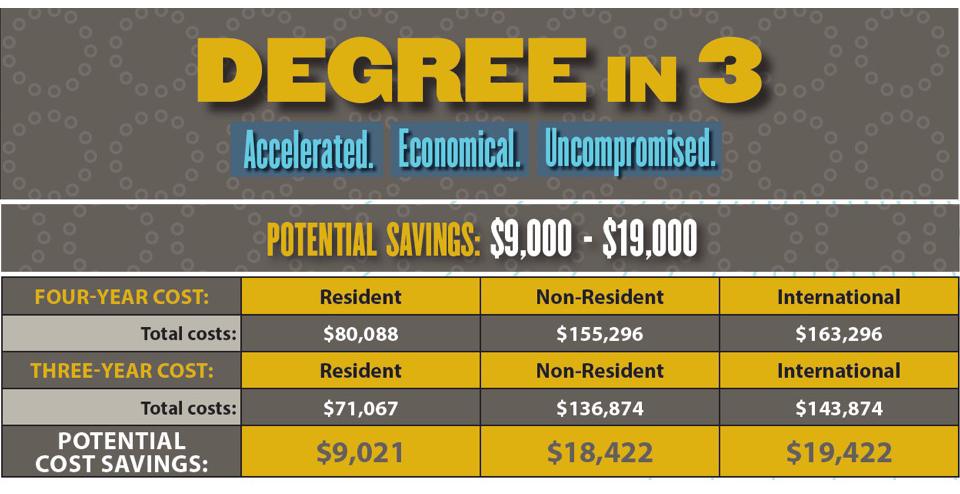
And yet, for all our self-congratulation about innovativeness, internally we remain mired in some astonishingly inefficient practices that it is our duty to modernize. Nothing is sadder than to see good people working very hard on tasks that are completely unnecessary. Dollars we waste in operations and administration are dollars that could have hired new professors, enhanced our compensation of the most productive employees, or simply been left in the pockets of our students and their families.
Months of analysis and planning preceded the launch last fall of our business process reforms. Examples of the improvements we seek are the reduction of more than 19,000 separate financial funds to 60 or fewer and the number of cost centers from 8,000 to 1,200, the elimination of paper time cards (yes, you read that correctly) and paper work orders. It turns out that we have been tracking as individual accounts one-time items like “pizza delivery” and “wristbands.” One account balance was 2 cents.
Perhaps the most difficult change will be the move this year to create common job titles and compensation categories. It seemed anomalous somehow that we have more than one unique job title (8,500 of them) for every two employees (15,000 total).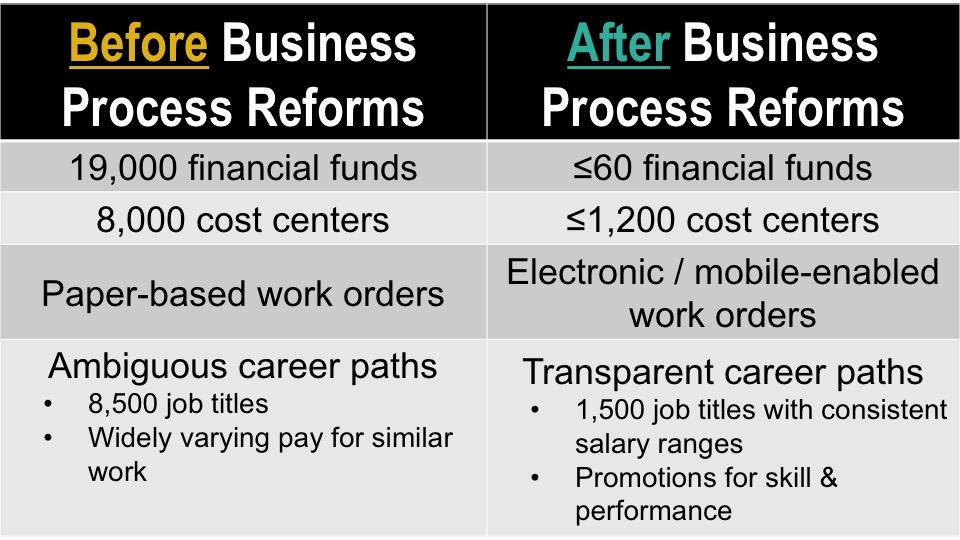
Less amusing but more damaging is a chaotic environment in which a person in one college is often paid dramatically more than a counterpart doing the same job in another unit. Frequently, staff members jump from one unit to another for more pay without being asked to do any more to earn it. It’s expensive and inefficient, but worse than that, it’s terribly unfair.
During 2018, we will reform this mess. While protecting (by “grandfathering”) existing salaries, we must transition to a system in which jobs are clearly defined, wages for equivalent work are equal across units, and opportunities for career advancement are transparent.
"NewU"
Of the many unusual actions Purdue has taken in recent years, none has attracted more attention than our announcement last March that we would purchase, for $1, the online Kaplan University. As both a higher education and business story, the move became national news from its first day and has remained a topic of discussion ever since.
Although we have stated our reasons for the move many times, they bear repeating as “NewU,” for which we will announce a permanent name soon, nears its launch this spring. First, in this era, we recognize that we cannot fulfill Purdue’s land-grant mission, to bring higher ed opportunities to the widest possible audience, if we stop at age 22. Tens of millions of adult Americans, including some three-quarters of a million working-age Hoosiers, started but never finished college. Neither they as individuals, nor our society in a global, knowledge-driven economy, can realize their potential if they go no further in enhancing their education and skills.
Second, after years of attempts, an honest assessment told us that Purdue was far behind many peers, to say nothing of the schools that specialize or are exclusively online, in the techniques and technologies that lead to effective distance learning. We have a world-class faculty, many of whom are eager to extend their teaching beyond campus to new audiences. What we do not have is a competitive means of delivering that content. The chance to acquire overnight that delivery competence was an opportunity not to be missed. As one longtime leader in the online education field told me, “You were fifteen years behind. You caught up in one day.”
Any major change generates debate and disagreement. Some members of the Purdue community have raised questions about the wisdom or the propriety of the “NewU” acquisition. Ultimately, 10% of our tenured or tenure-track faculty and 6% of all our faculty and lecturers signed a petition challenging the idea.
Their opposition has been criticized as “arrogance not based in fact”[v] or as one member of the Purdue University Senate put it as “academic snobbery”.[vi] But for the most part, their concerns have been natural and appropriate, and clearly sincere, reflecting the very same issues the Board of Trustees examined before agreeing to the transaction.
Some misinformation (in some cases, disinformation) to the contrary, we found no reasons for concern about either the integrity or the academic quality of the people soon to join the Boilermaker family. As a financial matter, the deal is very favorable and low-risk to Purdue.
The most serious question revolves around Purdue’s reputation and whether it might be diminished in some way by expanding the range of students to include more working adults. It’s not the first time such objections have been raised.
Maybe these statements sound familiar:
- These “colleges are resorting to all kinds of devices to get students.”[vii]
- [These institutions] are really universities “in aspiration rather than fact”; They pretend to the title of “university.”[viii]
- These schools are “robbing the U.S. Treasury.”[ix]
- “A foolish effort to substitute an imitation and a counterfeit article for the genuine ….”[x]
You might guess that they come from the current “NewU” debate. But in fact these are criticisms from the Morrill Act debates of the 1850s and 1860s, when Purdue and its land-grant counterparts were created. Similar disparagements likely accompanied the post-World War II expansion of Purdue’s mission to take in the returning GIs in the regional campuses that we operate today as Purdue Northwest and Purdue Fort Wayne. The democratization of higher ed, and its broader accessibility to wider sections of society, has always drawn detractors from within the incumbent system of the day.
Penn State has operated its online Penn State Global Campus for 20 years. The University of Maryland has served adult learners online through the University of Maryland University College since the mid-1990s. Neither university has suffered reputational damage. Rather, each has brought vital opportunity to working adults, military servicemen and women, and disabled citizens for whom coming to a residential campus is simply not an option.

Typically, voices of criticism have received vastly disproportionate attention compared to the many, highly credible statements of support for our “NewU” move. The Association of Public and Land-grant Universities issued a strong endorsement, saying “(D)elivering a high-quality education to an expanded and more diverse student body demands that public higher education embrace new models for learning…Purdue’s initiative is creative. (Purdue) is to be congratulated for seeking a new and positive approach to broadening access and degree completion.”
Others who have weighed in to applaud the move include President Obama’s Secretary of Education, Arne Duncan, nationally renowned scholars such as Dr. Arthur Levine of the Woodrow Wilson National Fellowship Foundation and Dr. Todd Rogers of the Harvard Kennedy School. Rogers, who has conducted randomized controlled experiments with Kaplan researchers for the last six years, stated that Kaplan has “…a genuine commitment to using learning and motivational sciences to improve student outcomes, and to conducting high quality research to become a leader in contributing to those sciences” and that Purdue’s acquisition will lead to “more learning and greater scaled implementation of interventions that help students succeed.” Dr. Harry Williams, president of the Thurgood Marshall College Fund, which claims to be the nation’s largest organization representing the black college community, wrote “…I’m pleased and inspired to see Purdue's proposal to acquire Kaplan University as a means of addressing adult learners that it's currently unable to serve through its West Lafayette and regional campuses.”
One of the most serious endorsements came from Ted Mitchell, the president of the American Council on Education and Obama's top higher education official. The former U.S. Department of Education under secretary described the learning platform Purdue is acquiring from Kaplan University as "among the best in the country." Echoing the conclusion of Harvard’s Dr. Rogers, he described Kaplan University as a learning science "'lab' whose continued work promises insights not only for ‘NewU’ but for Purdue and the wider field.” He went on to describe Kaplan University as having a "commitment to achieving high-quality outcomes..." and as a “pioneer in creating protections for students.” Finally, he wrote that the acquisition is “an effort by Purdue to extend its unquestioned tradition of educational excellence and its land-grant mission by leveraging the tools, technologies, and practices that Kaplan has developed, to reach more and different students." 
Dr. Mitchell’s statement and others can be examined here.
Ultimately, it won’t be either the supporters’ or the critics’ forecasts that matter, but rather the results. Kaplan University graduates achieve excellent results today in better jobs and higher wages. If we do our job well, these outcomes will continue and improve; as part of our governance of "NewU," we plan to constantly analyze and report them publicly.
Nothing matters to our Board or to us as stewards of your university more than the protection and steady enhancement of its sterling, worldwide reputation. By every measure, such as applications, counts of positive news reports, and awards and recognitions, Purdue's reputation has strengthened over recent years. The “NewU” Board has already instituted a strict code of conduct governing academic quality, marketing practices, transparency and accountability that go beyond any explicit requirements we impose at the main campus. It’s our intention that this widening of Purdue’s land-grant mission will not merely preserve but will augment Purdue’s well-earned worldwide image.
Rigor at Purdue
Last year’s letter raised the issue of rigor in teaching and grading. The striking phenomenon of “grade inflation,” in which average college grades keep drifting up and up (despite documented lighter reading and homework loads) runs counter to the longtime Purdue culture of challenging students and pressing them to reach their full potential. As best one can tell, our average grade may no longer be substantially below the national average. If so, and if this shift is evidence that our traditional culture has softened over recent years, it presents the question whether this is a desirable, inevitable, or troublesome trend.
During 2017, members of the University Senate performed a tremendous service by gathering a wealth of data about grades at Purdue. Among many fascinating findings the committee reports:
- Between 2002 and 2016, “A’s” rose from 35% to 45% of all grades given. DFW’s (dropped/failed/withdrew) have declined slightly, but in the biggest shift, C’s have become B’s, while B’s have become A’s.
- Freshman grades have escalated dramatically. Startlingly, the average freshman GPA is now higher than that for sophomores, a phenomenon rarely seen until recently.
- Summer school grades are higher than those in the longer semesters. Is this because of more motivated students? Students retaking courses in which they were dissatisfied with their first performance?
- In English 106, taken by a sizable majority of all students, 69% of recent grades were A’s. This despite the seemingly unanimous faculty view that today’s students as a group write poorly, noticeably worse than their predecessors.
Previous analysis has suggested that perhaps half the recent upward movement in GPAs is attributable to the steadily increasing quality of entering freshmen. As I often say to visiting applicants, “Your dad probably couldn’t get in here today, but I’m sure you can!” (The father invariably agrees.)
To be sure, other factors, such as the amount of reading and writing demanded, can figure in any calculation of overall rigor. And as a campus we’ve made efforts to improve the learning outcomes of all our students, especially those at most risk. We must attempt to gather information on those fronts as well. But the preliminary committee findings leave little room for doubt that, overall, high grades are now easier to come by at Purdue. Which leads to the question, should we accept this trend or look for ways to resist it?
The grade inflation effect is now even more pronounced in the K-12 setting. A study last year revealed that “A’s” are now the most common grades given in American high schools. This comes in spite of poor performance for American students vs. international students on standardized tests, and SAT scores stagnant at best for decades.
In too many places, “self-esteem” has apparently taken precedence over candor in student assessment. For many of our arriving students, anything less than an A comes as a jolt and a rude surprise. The student evaluations of our faculty which are collected at the end of each term are thought by many to be heavily tilted toward professors who are less demanding or inclined to easier grading.
The senators plan to issue a final report early this year. In addition to more complete findings, it will list options for the faculty and provost to consider if in fact we decide to lean against the general flow and try to maintain Purdue’s stance as a place of genuine rigor where high marks are a sure badge of achievement.
My bias on this topic is evident. I believe that, in a sea of leniency, a university that maintains tough standards of performance will set itself and its graduates apart in a highly positive way. Purdue’s record of nearly universal job placement supports this contention.
But, as much as any issue we face, the degree of rigor Purdue demands is a matter for our faculty as a whole to determine. With more than 2,000 individuals giving grades, no policy anyone could enunciate would make much difference. The answer must be cultural, a collective expression of commitment to a somewhat different standard, to which at least a large majority of our faculty subscribes. It’s an important discussion; simply having it at all probably separates us from most other higher ed institutions.
Affordability and Access
One area in which Purdue is plainly differentiated from its competition involves our philosophy about student cost. Our tuition freeze will enter its sixth consecutive year this fall; in May, the third of what will be at least four classes will graduate having never seen a tuition increase. In fact, due to reductions in food and books costs, it will be less expensive to attend Purdue in 2019 than it was in 2012. Put another way, if we had raised tuition and fees at the average national rate, resident students would pay $1,400 more annually. [xi]
As a consequence, total student debt is down 37% (despite a significantly larger student body). That amounts to $232 million since 2012 that would otherwise have been borrowed and carried into adult life by graduating Boilermakers. Of 2017 graduates, 56% left debt-free. That’s the highest percentage in the 20 years for which we have comparable data.
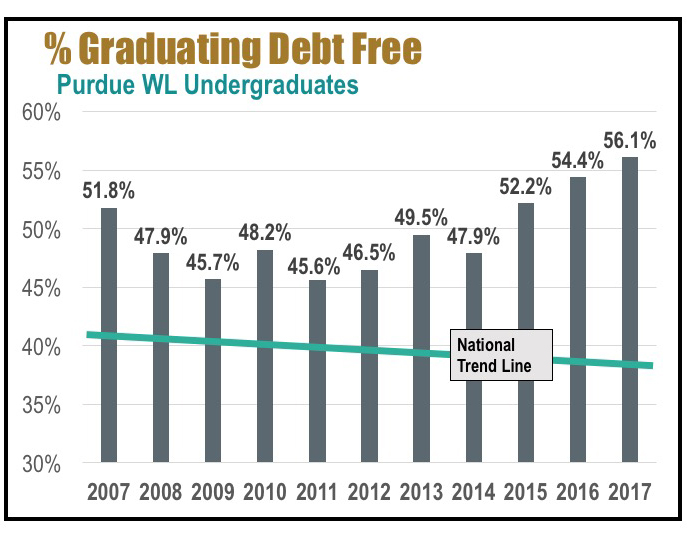 But a Purdue education is still not cheap, and still a major challenge for many low- and middle-income households. So our campus-wide commitment to affordability continues to produce ways to bring our costs further into financial reach.
But a Purdue education is still not cheap, and still a major challenge for many low- and middle-income households. So our campus-wide commitment to affordability continues to produce ways to bring our costs further into financial reach.
In November, our Division of Financial Aid unveiled the Boilermaker Affordability Grant (BAG). It provides a guarantee to every Hoosier family up to $70,000 in adjusted gross income that Purdue will close whatever gap remains after the Expected Family Contribution (a standard calculation under the federal loan system) and any grants or scholarships the student has received. It’s our hope that this new assurance, easily understood and known well in advance of an enrollment decision, will bring to Purdue a number of qualified Indiana students who might otherwise have hesitated to join us.
Obviously, the time will come when some upward adjustment of student charges will be necessary. But our philosophy will remain: As long as we are balancing our operating budget, growing our faculty, investing in necessary capital projects, increasing staff compensation competitively, all without tapping our cash reserves, why would we raise tuition?
2017 brought many reasons for pride in your university. Again, we saw new records for research, applications, patents, donations, and more. Again, the Wall Street Journal and Times Higher Education ranked Purdue in the nation’s public top 5, with Michigan, UCLA, North Carolina, and Cal Berkeley. As far as I’m concerned, those schools should be thrilled to be listed with us.
But Boilermakers believe in continuous improvement, always reaching a “brick higher.” As our 150th birthday approaches (stay tuned for an announcement about how we will commemorate it), what better way to celebrate than with another year of even greater achievements, and a growth of Purdue’s service to state and nation by bringing quality education to additional thousands of our fellow citizens.
Happy New Year. Boiler Up!
![]()
Mitchell E. Daniels, Jr.
President
[i] National Student Clearinghouse Research Center, 2017. https://nscresearchcenter.org/current-term-enrollment-estimates-fall-2017/
[ii] “On-Campus Enrollment Shrinks While Online Continues its Ascent.” Dian Schaffhauser, May 2017. https://campustechnology.com/articles/2017/05/02/on-campus-enrollment-shrinks-while-online-continues-its-ascent.aspx
[iii] See also https://www.insidehighered.com/news/2017/07/19/number-colleges-and-universities-drops-sharply-amid-economic-turmoil
[iv] https://www.purdue.edu/newsroom/releases/2014/Q2/purdue-technology-centers,-purdue-foundry-recognized-by-nbia.html
[v] The Exponent, Nov. 6, 2017. https://www.purdueexponent.org/city_state/article_166dcb36-ffcf-5613-b3d5-1568e8d9d1e8.html
[vi] Professor John Niser. Aug. 1, 2017. Correspondence with Senate leadership.
[vii] The Carnegie Foundation for the Advancement of Teaching. "Fourth Annual Report of the President and of the Treasurer." New York: Carnegie Foundation, 1909.
[viii] As quoted by Lucas, Christopher J. American Higher Education: A History. 2nd Edition. New York: Palgrave MacMillan, 2007. 159.
[ix] As quoted by Burton, Vernon. “Lincoln and the Founding of ‘Democracy’s Colleges’”. Lincoln Remembered series, September 2008, published by the College of Liberal Arts & Sciences, University of Illinois at Urbana-Champaign.
[x] Paraphrasing from President James Buchanan Veto Message presented to the House of Representatives of the United States, Feb. 24, 1859.
[xi] Compared to the average national tuition and fee increases since AY 2012-13 at 4-year public universities. College Board, 2017. https://trends.collegeboard.org/sites/default/files/cp-2017-table-2.xls